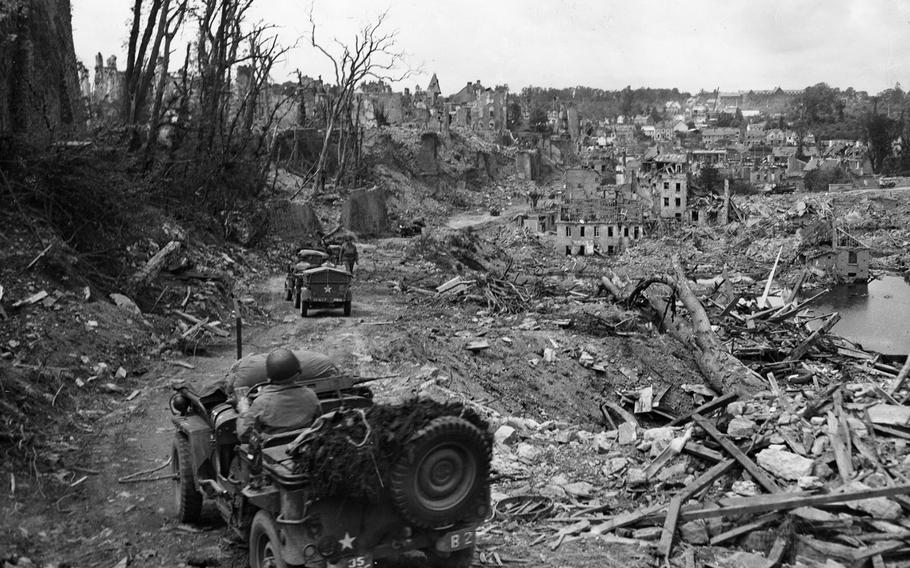
The French town of Saint-Lo is left in rubble and ruin following some of the bitterest fighting in World War II. The town was 95% destroyed before it was captured from Germans on July 18, 1944. The victories in Normandy and Northern France paved the way for the Allies triumphant entry into Paris in August 1944. (Department of Defense)
The heroic image of soldiers storming the beach at Normandy understandably dominates the collective American memory of D-Day, but the operation had a dark side that 75 years later remains a footnote: the toll on French civilians.
More than 60,000 noncombatants were killed in connection with a D-Day bombing campaign by the Allies, which began three months earlier to isolate the battlefield ahead of the June 6, 1944, ground invasion.
“Americans have no idea about it,” said Stephen Bourque, professor emeritus of military history at the School of Advanced Military Studies in Fort Leavenworth, Kan. “I never had any idea of the scale and scope.”
The destruction wasn’t limited to bridges, rail lines and military posts used by the Germans in occupied Norman towns. Homes, churches and historic buildings were leveled. Bourque is shining a light on the forgotten history in his recently published book, “Beyond the Beach,” which examines the Allied air assault on France.
The lore surrounding D-Day attracts thousands every year to Normandy, where especially large crowds are expected this year to mark the operation’s 75th anniversary. D-Day is “big business” yet there is discomfort in dwelling on its uglier side, Bourque said.
But awareness of the civilian toll is growing, at least in France. “This stuff is starting to come out now,” he said.
Leading into the invasion at Normandy, Gen. Dwight D. Eisenhower wanted to make sure German troops would be cut off. Allied commanders were deeply worried about the German ability to reinforce its flank, taking advantage of French transportation infrastructure that could make it easy to ferry supplies and troops to the front.
Civilians would be hit and Allied commanders knew it, said Bourque, whose book was published by the Naval Institute Press.
Towns that were flattened include Tilly-la-Campagne, Vire, Villers-Bocage, Le Havre, Caen, Falaise, Lisieux and Saint-Lo.
“I spent my whole life thinking the town of Saint-Lo was destroyed during the battle of Saint-Lo. I had no idea it was Allied bombing,” Bourque said.
Conflicted feelings over the destruction lingered long afterward among some French veterans.
In a 2014 interview, Andre Heintz, then 94, recalled the bombing of Caen, where he was a 24-year old resistance fighter.
“I was haunted by what I saw — it was terrible to see so many wounded. It was difficult to bear,” Heintz told Britain’s The Guardian newspaper.
“Obviously it was a crime to cause such destruction and kill so many people, but probably it was the only thing to stop the Germans long enough from rushing towards the sea,” he said.
The Allied bombers served as Eisenhower’s “long-range heavy artillery.”
From the start of the campaign through June 6, 22,000 aircraft had dropped more than 42,000 tons of bombs on 100 railway targets in the Seine Valley, between Le Havre and Paris, according to the D-Day Commemoration Committee in France. German military positions and radar bases also were hit.
The second phase of the bombing campaign began after dark June 5, when British bombers began pulverizing the Normandy coastline. At dawn, more than 1,500 American bombers took over. “That morning, a dozen urbanized areas and their road and rail infrastructures were also targeted,” according to a D-Day commemoration committee’s synopsis of the air campaign. “As at Caen, Flers, Conde-sur-Noireau and Lisieux disappeared in flames.”
During the mission, low clouds, fire and smoke made it hard to identify targets, so towns were bombed again. The U.S. 8th Air Force hit a dozen towns with the aim of preventing the German forces from advancing toward the beaches, the D-Day committee’s history states.
Despite the damage and high civilian casuality numbers — more French civilians were killed in the brief Allied air campaign than the number of American troops killed in the entire Vietnam War — the history gets passing reference in many accounts.
A few European authors have devoted books to it and Bourque is the latest historian to delve into the issue of civilian casualties. “I think I am the first American to write anything about this,” he said.
In the U.S., much of the public’s understanding of D-Day has been shaped by films that documented the against-the-odds battlefield exploits. Movies like “Saving Private Ryan” and the series “Band of Brothers” didn’t shy away from the brutality of war, but it’s largely seen from the perspective of how it was experienced by American troops.
Yet the toll on French civilians during the air campaign in support of D-Day operations was extraordinary and unique. While some mass deaths are well documented — the civilian toll of the fire bombings of Tokyo and Dresden are examples — the air assault on France is unusual in that Allied civilians were on the receiving end.
Even the U.S. military shies away from D-Day’s dark side in its own historical record of World War II. “They don’t want to talk about it from a cultural point of view,” Bourque said.
At least 60,000 civilians were killed, but the numbers could have been more than 70,000, Bourque said.
“It’s not a simple narrative. It’s a complex narrative and it’s hard,” he said.